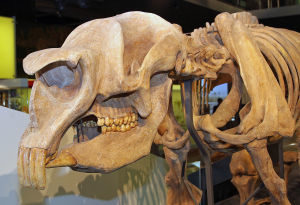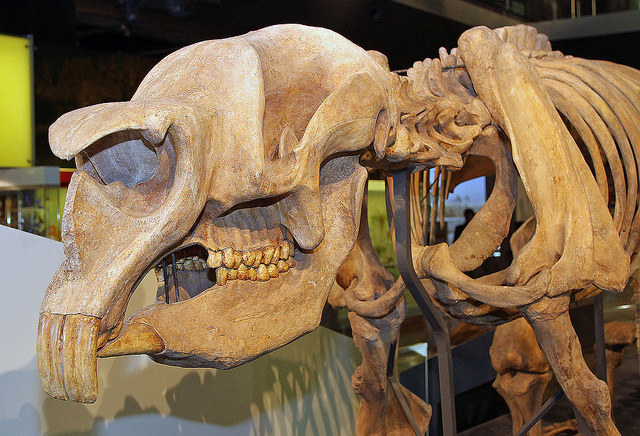
VANDERBILT UNIVERSITY—During the last Ice Age, Australia, Tasmania and New Guinea formed a single landmass, called Sahul. It was a strange and often hostile place populated by a bizarre cast of giant animals.
There were 500-pound kangaroos, marsupial tapirs the size of horses and wombat-like creatures the size of hippos. There were flightless birds that weighed twice as much as modern emu, 33-foot snakes, 20-foot crocodiles, 8-foot turtles with horned heads and spiked tails, and giant monitor lizards that measured greater than 6 feet from tip to tail and were likely venomous.
By about 30,000 years ago, however, most of these ‘megafauna’ had disappeared from the Sahul as part of a global mass extinction that saw the end of nearly all of the super-sized animals that had evolved to survive in extreme Ice Age climates. The factors that forced the Australian megafauna into extinction remain a matter of considerable controversy. Many experts argue that the ancestors of the Australian aborigines, who made an appearance approximately 50,000 years ago, either hunted them into extinction or gradually destroyed the habitat they required by practices such as fire-stick burning. Others argue that the gradual drying out of Australia and weakening of the Australian monsoon played a major role in their demise.
A new study has compared the diet of a variety of Australian megafaunal herbivores from the period when they were widespread (350,000 to 570,000 years ago) to a period when they were in decline (30,000 to 40,000 years ago) by studying their fossil teeth. The analysis suggests that climate change had a significant impact on their diets and may well have been a primary factor in their extinction.
“We have found evidence that, as the climate was changing and getting drier, animal diets were shifting dramatically,” said Larisa DeSantis, assistant professor of earth and environmental studies at Vanderbilt University, who directed the study. “If climate change was a primary or contributing factor in their demise, as it appears, we need to pay more attention to how current levels of climate change are affecting animals today.”
The results of the study are described in a paper titled “Dietary responses of Sahul (Pleistocene Australia-New Guinea) megafauna to climate and environmental change” published Jan. 26 by the journal Paleobiology. Co-authors on the paper are Judith Field and John Dodson from the University of New South Wales and Stephen Wroe from the University of New England.
Michael Archer, a leading Australian paleontologist at the University of New South Wales who was not involved in the study, commented, “This new study, based on hard evidence, makes it clear that changes in late Pleistocene climate had a major impact on the late Pleistocene megafauna of Australia, adding even more evidence to challenge the imaginative a priori assumption that ‘blitzkrieg’ by early humans caused the extinction of this continent’s lost megafauna. Climate change clearly has been in the past and will continue to be a major cause of extinction into the future.”
The teeth that were analyzed came from the Cuddie Springs site in southeastern Australia. It is located on a prehistoric ephemeral lake and it is the only site on mainland Australia that has produced fossil evidence of the co-existence of humans and megafauna. “Unfortunately, many of the advocates of the human predation hypothesis have discounted Cuddie Springs because it does not support the popular ‘blitzkrieg’ theory that maintains the megafauna went extinct in the 1,000-year period after humans arrived on the scene,” said DeSantis.
It’s amazing how much information about the prehistoric environment paleontologists can extract from fossil teeth using a dental drill, dental impression material and some sophisticated instruments. The ratios of oxygen and carbon isotopes locked in the enamel provide clues about the animals’ diet and the average temperature and humidity of the environment at the time the teeth formed.
_______________________________________
Skull of Diprotodon optatum, extinct Australian marsupial megafauna, at the Melbourne Museum. The specimen clearly shows the large front teeth for which the genus is named (Diprotodon = “two forward teeth”) and the dentition adapted for browsing. Melbourne, Victoria, Australia. jjron, Wikimedia Commons
___________________________________________________
Differences within individual teeth mirror climate variability. Analysis of the microscopic scratches on the surface of the teeth provides evidence of what the animal was eating in the last few weeks of its life. Differences in wear-patterns can differentiate between animals that were grazing on grass and browsing on bushes.
“For example, we know from the analysis of modern day kangaroos that oxygen isotope ratios in their teeth are highly correlated with the relative humidity and amount of precipitation in their environment,” DeSantis said. “This makes them ideally suited for tracking changes in aridity over time.”
During the megafaunal heyday around 500,000 years ago, the dental analysis revealed that the climate was semi-arid. In addition, the animals’ diets were highly variable, implying that there were a number of ecological niches available to them. That contrasts markedly with the period from 30,000 to 40,000 years ago. Here, the analysis indicates that the climate was substantially drier and the diet of the giant herbivores was considerably more restricted.
“It appears that long-term aridification may have reduced the ability of megafauna to consume certain types of plants, including salt-bush. Eating salt-rich plants requires drinking additional water that was less available and likely increased competition for similar plant resources,” said DeSantis. “These data clarify the impacts of climatic change on marsupial megafauna and suggest that the long-term drying out of Australia, identified here and in other records, likely played a key role in the decline and disappearance of this unique suite of animals.”
_____________________________________________________
Article Source: Vanderbilt University
The work was supported by National Science Foundation grants EAR1053839 and FAIN1455198, Australian Research Foundation grants ARC LP211430 and DPO5579230, University of New South Wales, the University of Sydney, Oak Ridge Associated Universities and Vanderbilt University.
______________________________________________________
Subscribe to Popular Archaeology Premium. Available on all laptops and mobile devices, and still the industry’s best value at only $9.00 annually.
___________________________________________
Travel and learn with Far Horizons.
____________________________________________
This richly illustrated issue includes the following stories: Recent findings shedding new light on the whereabouts of the remains of Philip of Macedon, father of Alexander the Great; how an archaeologist-sculptor is bringing bones of the dead back to life; archaeologists uncovering town life at the dawn of civilization; an exclusive interview with internationally acclaimed archaeologist James M. Adovasio about what makes the Meadowcroft Rockshelter prominent in the ongoing search for the first Americans; what archaeologists are finding at the site of the ancient city of Gath, the home town of the biblical Philistine giant, Goliath; and how scientists are redrawing the picture of human evolution in Europe. Find it on Amazon.com.






